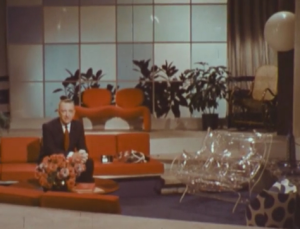How Far Off Were The Predictions Of 1967’s Home Of The Future?
Back in March of 1967, Walter Cronkite dedicated an entire episode of his forward-looking show “The 21st Century” to the home of the future.
We’ve included some of the videos below, and the Smithsonian’s Paleofuture blog has a great write-up of the episode, which makes predictions of the devices you’d see in everyday homes in 2001.
Even forgiving the 2001 date and giving Cronkite an extra 12 years to get to 2013, there are more than a few predictions that were about as accurate as scouts who thought Ryan Leaf would make a good NFL quarterback. That being said, there are a number of things that are available now, though often in a very different format than what was imagined more than 40 years go.
THE LIVING ROOM
Cronkite shows a huge console with knobs, switches and dials that control everything from the TV to the stereo to the tint of the windows. Much of this is doable now, without the need for a mammoth console that makes it look like you’re running the lights for a Pink Floyd concert.
In fact, many of these functions are controllable straight from one’s computer or smartphone/tablet. That being said, the fully networked home is still a very recent development, and very few homes have Smart Glass windows.
THE HOME OFFICE
The first thing that ages this clip is Cronkite’s assertion that the home office of the future “is where the man might spent most of his time in the home of the twenty-first century.” Apparently, the futurists of the 1960s could imagine all sorts of gadgets, but not the fact that a female might have a job requiring a home office.
Then there’s the separate machine that consolidates news from all over the world and allows him to print it out onto a huge broadsheet. We now call this the Internet, and most people don’t find the need to print things out to read them.
Of course, there’s a videophone. Variations of this tech have been around for decades, though I’ve found that most people who work in home offices hate talking over video because they don’t want anyone to see they are wearing a sweatsuit.
A completely separate monitor provides stock and weather updates, and yet a third screen allows for monitoring of the house via closed-circuit TV cameras.
Aside from the ridiculous newspaper printer, the functions in the home office are all readily available now, and certainly without the huge, multi-monitor set-up shown in 1967.
THE KITCHEN
The kitchen is the one room in which the futurists really missed the mark.
“Preparation of a meal in the 21st century could be almost fully automatic,” says Cronkite of the kitchen in which meals made from “frozen or irradiated foods” are programmed into a menu that is “given to the automatic chef via typewriter or punched computer cards.”
The robotic chef would then get the necessary ingredients, put them together and microwave the entire thing “in seconds.”
It gets better.
Rather than having to fetch plates from the cupboard, instantly molded plastic plates, cups, and saucers are dispensed right onto the table.
“When I’ve finished eating, there will be no dishes to wash,” explains the venerated newsman. “The used plates will be melted down again, the leftovers destroyed in the process and the melted plastic will be ready to be molded into clean plates when I need them next.”
So we’re not quite there yet, but as anyone who has studied the Back to the Future series knows, we are only a few years away from hoverboards and a Chicago Cubs World Series victory.
Want more consumer news? Visit our parent organization, Consumer Reports, for the latest on scams, recalls, and other consumer issues.


